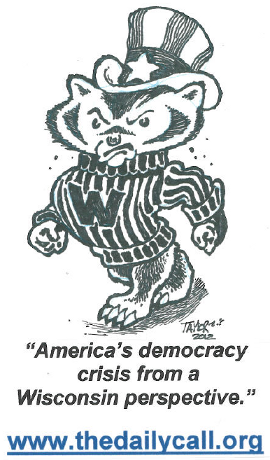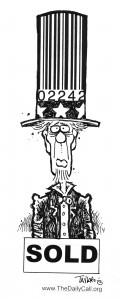Wall Street is very much intertwined with the Clintons. I doubt that will change anytime soon.
By Chris Arnde
The Guardian (1/28/16)
I owe almost my entire Wall Street career to the Clintons. I am not alone; most bankers owe their careers, and their wealth, to them. Over the last 25 years they – with the Clintons it is never just Bill or Hillary – implemented policies that placed Wall Street at the center of the Democratic economic agenda, turning it from a party against Wall Street to a party of Wall Street.
That is why when I recently went to see Hillary Clinton campaign for president and speak about reforming Wall Street I was skeptical. What I heard hasn’t changed that skepticism. The policies she offers are mid-course corrections. In the Clintons’ world, Wall Street stays at the center, economically and politically. Given Wall Street’s power and influence, that is a dangerous place to leave them.
Salomon Brothers hired me in 1993, seven months after President Bill Clinton’s inauguration. Getting a job had been easy, Wall Street was booming from deregulation that had begun under Reagan and was continuing under Clinton.
When Bill Clinton ran for office, he offered up him and Hillary (“Two for the price of one”) as New Democrats, embracing an image of being tough on crime, but not on business. Despite the campaign rhetoric, nobody on the trading floor I joined had voted for the Clintons or trusted them.
Few traders on the floor were even Democrats, who as long as anyone could remember were Wall Street’s natural enemy. That view was summarized in the words of my boss: “Republicans let you make money and let you keep it. Democrats don’t let you make money, but if you do, they take it.”
Falling into line with Wall Street
Despite Wall Street’s reticence, key appointments were swinging their way. Robert Rubin, who had been CEO of Goldman Sachs, was appointed to a senior White House job as director of the National Economic Council. The Treasury Department was also being filled with banking friendly economists who saw the markets as a solution, not as a problem.
The administration’s economic policy took shape as trickle down, Democratic style. They championed free trade, pushing Nafta. They reformed welfare, buying into the conservative view that poverty was about dependency, not about situation. They threw the old left a few bones, repealing prior tax cuts on the rich, but used the increased revenues mostly on Wall Street’s favorite issue: cutting the debt.
Beginning the bankster bailouts
Most importantly, when faced with their first financial crisis, they bailed out Wall Street.
That crisis came in January 1995, halfway through the administration’s first term. Mexico, after having boomed from the optimism surrounding Nafta, went bust. It was a huge embarrassment for the administration, given the push they had made for Nafta against a cynical Democratic party.
Money was fleeing Mexico, and much of it was coming back through me and my firm. Selling investors’ Mexican bonds was my first job on Wall Street, and now they were trying to sell them back to us. But we hadn’t just sold Mexican bonds to clients, instead we did it using new derivatives product to get around regulatory issues and take advantages of tax rules, and lend the clients money. Given how aggressive we were, and how profitable it was for us, older traders kept expecting to be stopped by regulators from the new administration, but that didn’t happen.
When Mexico started to collapse, the shudders began. Initially our firm lost only tens of millions, a large loss but not catastrophic. The crisis however was worsening, and Mexico was headed towards a default, or closing its border to money flows. We stood to lose hundreds of millions, something we might not have survived. Other Wall Street firms were in worse shape, having done the trade in a much bigger size. The biggest was rumored to be Lehman, which stood to lose billions, a loss they couldn’t have survived.
As the crisis unfolded, senior management traveled to DC as part of a group of bankers to meet with Treasury officials. They had hoped to meet with Rubin, who was now Treasury secretary. Instead they met with the undersecretary for international affairs who my boss described as: “Some young egghead academic who likes himself a lot and is wide eyed with a taste of power.” That egghead was Larry Summers who would succeed Rubin as Treasury Secretary.
To the surprise of Wall Street, the administration pushed for a $50bn global bail-out of Mexico, arguing that to not do so would devastate the US and world economy. Unmentioned was that it would have also devastated Wall Street banks.
The bailout worked, with Mexico edging away from a crisis, allowing it to repay the loans, at profit. It also worked wonders on Wall Street, which let out a huge sigh of relief.
Blueprint of bailouts without consequence
The success encouraged the administration, which used it as an economic blueprint that emphasized Wall Street. It also emphasized bailouts, believing it was counterproductive to let banks fail, or to punish them with losses, or fines or, God forbid, charge them with crimes, and risk endangering the economy.
The use of bailouts should have also been a reason to heavily regulate Wall Street, to prevent behavior that would require a bailout. But the administration didn’t do that; instead they went the opposite direction and continued to deregulate it, culminating in the repeal of Glass Steagall in 1999.
It changed the trading floor, which started to fill with Democrats. On my trading floor, Robert Rubin, who had joined my firm after leaving the administration, held traders attention by telling long stories and jokes about Bill Clinton to wide-eyed traders.
Wall Street now had both political parties working for them, and really nobody holding them accountable. Now, no trade was too aggressive, no risk too crazy, no behavior to unethicaland no loss too painful. It unleashed a boom that produced plenty of smaller crisis (Russia, Dotcom), before culminating in the housing and financial crisis of 2008.
The response to that crisis was Mexico 1995 writ large: bailout the banks and save Wall Street. This time executed by an Obama administration filled with veterans of the Clinton administration, including Hillary Clinton and Larry Summers. Prior to joining Obama’s administration as a senator, Hillary Clinton voted to bail-out the banks, a vote she still defends.
More than 23 years following Bill Clinton’s election, Wall Street is very much intertwined with the Clintons: they helped fundamentally change Wall Street, and Wall Street fundamentally changed the Democratic party. So maybe they really do know what it takes to reform both.
Maybe. Except that Hillary Clinton continues to receive large donations from top bankers. Ask anyone who has spent the last two decades on Wall Street which politicians have worked for them the hardest and most will grudgingly admit it’s the Clintons. I doubt that will change anytime soon.
- Clinton Laughs Off Question on Goldman Sachs, But Can Millions in Special Interest Cash Be Ignored? — The Intercept’s Lee Fang recently questioned Hillary Clinton about her speeches for Wall Street giant Goldman Sachs, which paid her $675,000 for just three appearances. After a town hall in Manchester, New Hampshire, Fang asked Clinton if she would release the transcripts of her paid speeches to Goldman Sachs. Clinton laughed and turned away. Fang joins us to discuss Clinton’s Wall Street ties along with Ellen Chesler, a senior fellow at the Roosevelt Institute and longtime Clinton supporter. Link to Story and 5-Minute Video




